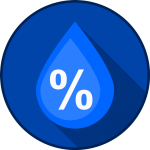May 6, 2019
What is the difference between relative and absolute humidity?

Relative humidity VS. Absolute humidity: what’s the difference?
When talking about humidity, we are talking about the degree of moisture condition of the air. In general, when we commonly use the term “humidity”, its actually meaning refers to “relative humidity”. However we can also indicate the degree of humidity with the term “absolute humidity”.
Let’s explain the difference in these two terms.
What is humidity?
Humidity is the amount of water present in the air. To represent the ratio of the amount of moisture in the air, the definition of the air can be classified as follow:
- Dry air = Air without any moisture
- Humid air = Air in which a small amount of moisture is mixed
- Saturated air = Air that can not contain any more water
Generally, the air around us is “humid air” and is mixed with oxygen, nitrogen, carbon dioxide, etc. as well as water. “Moisture” in the air does not exist as water droplets (liquid), but exists as vaporized water (water evaporated to gas), so it is invisible to the eyes.
What is dew condensation?
When the humidity reaches 100%, it is in the state of saturated air. The air can not contain any more moisture.
In this state, when the saturated air gets in contact with a cooler air like air coming from outside, it gets cool down. Therefore, the amount of vaporized water contained in the saturated air decreased. As a result, the moisture can not remain as vaporized state, and water droplets are formed on the contact surface. This is “dew condensation”.
Difference between “relative humidity” and “absolute humidity”
Relative humidity
Relative humidity is a value that indicates how much moisture the air contains as compared with the maximum amount of moisture that can be contained in the air at a certain temperature.
It is expressed as [ % RH ] and is generally used to represent humidity.

Absolute humidity
Absolute humidity represents the weight ratio of vaporized water to 1 kg of dry air (moisture-free air) in a humid air.
It is expressed as [ kg / kg’ ].

Example of using relative and absolute humidity
Let’s take a visual example with air being a room with a fixed number of seats and moisture being a number of people (1 person = 1 water droplet). If we have 16 seats, but only 8 people are seated.
- Relative humidity = it is the percentage of how many seats are filled with the number of seats. So in this case, the relative humidity is 50%.
- Absolute humidity = it is the number of people. So if one person is equal to 0.001 kg, then the absolute humidity is 0.008 kg/kg ‘(= 8 people sitting).
However, the number of seats varies with the temperature.
If you are located outside the European Union and the European Economic Area,
